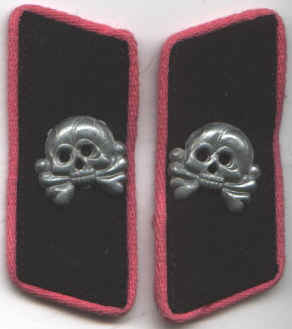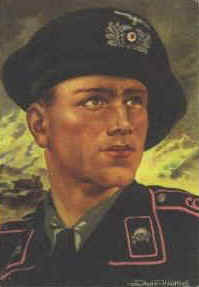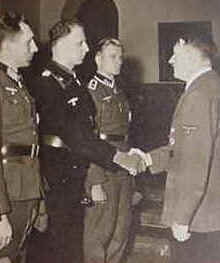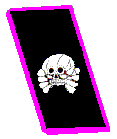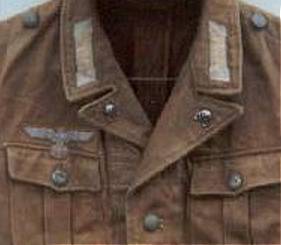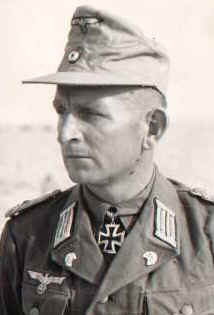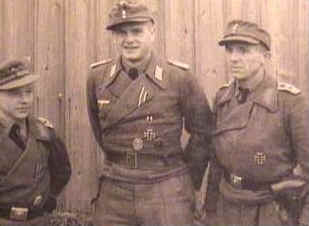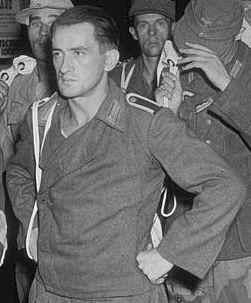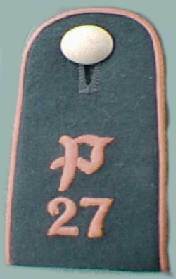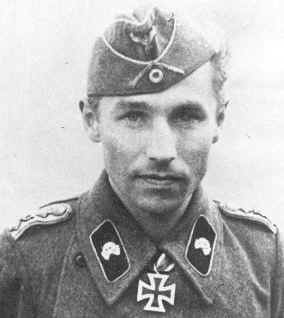| As men in other trades began assuming the wear
of the AFV uniform, patches in their waffenfarbe were created. The 24th Panzer
Division, the only panzer division to be created directly from a former cavalry unit,
retained their golden yellow piping, but reconaissance troops in other divisions who wore
the AFV uniform also wore this waffenfarbe. Armoured signal troops and artillery
troops began to wear the AFV uniform, and in May 1940, armoured pioneer troops adopted a
black and white "twist piping" for use on uniform accoutrements. The
introduction of the field grey AFV uniform alleviated the need for twist piping, as the
traditional black waffenfarbe stood out against the field grey collar patches and shoulder
straps. |
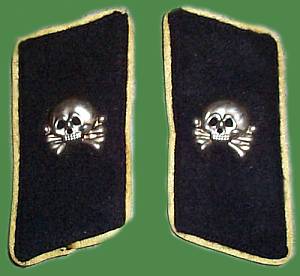 |
Michael Pruett, author of FIELD
UNIFORMS OF GERMAN ARMY PANZER FORCES IN WORLD WAR TWO and co-author of FIELD UNIFORMS OF
GERMANY'S PANZER ELITE provides the following information on the various collar patches
worn on the black AFV uniform::
Totenkopf
Collar Patches
Black AFV Uniform
Colours mentioned includes piping on the collars, collar tabs, and
shoulderstraps/boards. |
| 1934 - 1937 |
| Panzertruppen |
Armoured troops |
| Stab and Panzerspähkompanien in
Aufklärungs-Abteilungen (mot.) |
Headquarters and Armoured Car companies in
Motorized Reconnaissance Units |
| Panzernachrichten |
Armoured Signals troops |
| Changes and Additions |
| Panzernachrichten (Armoured
Signals) changed to Lemon Yellow in 1937 Stab
and Panzerspähkompanien in Aufklärungs-Abteilungen (mot.) changed to Golden Yellow
(except for Motorized Reconnaissance Units in 1st, 2nd, 4th and 5th Panzer Divisions, who
continued to wear pink)
Beobachtungsbatterie in Artillerie-Regimenter (mot.)
(Oberservation Batteries in Motorized Artillery Regiments) adopted pink patches etc. in
1938 as did crews of Sd Kfz 265 Kleiner Panzerbefelswagen. |
| 1940 |
| Panzerabwehrkompanien. Equipped with 4.7cm
Pak (t) (Sf) auf Pz Kpfw I Ausf. B. |
Anti Tank Units using the PzKpfw I ausf B |
| Schwere Infanteriegeschützkompanien (mot.)
701 - 706 |
Heavy Infantry Gun Company (Motorized),
numbers 701 to 706 |
| 1941 |
| Panzerjägerkompanien. Renaming of the
Panzerabwehr Eisenbahnpanzerzüge. |
Literally (tank hunting companies), this was
a renaming of anti-tank units (or "tank defence" units). |
| |
|

Rose Pink
|
| 1937 |
| Artillerie Lehr Regiment Jüterbog |
Artillery Training Regiment Jüterbog |
|

Rose Pink
sans skull
|
| 1937 |
| Panzernachrichten |
Armoured Signals troops |
|

Lemon Yellow
|
| 1938 |
| Panzerspähkompanien in
Aufklärungs-Abteilungen (mot.)* |
Headquarters and Armoured Car companies in
Motorized Reconnaissance Units* |
| *
Except those in 1st, 2nd, 4th and 5th Panzer Divisions |
| Aufklärungs-Regimenter in the Leichte
Divisions. |
Reconnaissance Regiments in Light Divisions |
| 1941 |
| Panzer Regiment 24 of the 24th
Panzer Division retained Golden Yellow piping; the division was a redesignation of the 1st
Cavalry Division who had worn golden yellow. |
|

Golden Yellow
|
| 1939 |
| Stab and Panzerspähkompanien in
Aufklärungs-Abteilungen (mot.) |
Headquarters and Armoured Car companies in
Motorized Reconnaissance Units |
| Some units continued to wear rose
pink and golden yellow, however |
|

Copper Brown
|
| 1940 |
| Black & white twist piping 3rd or 2nd
Kompanie (depending on unit) in Panzerpionier-Bataillon |
2nd or 3rd Company of Armoured Engineer
Battalion |
| Black and white "twist" piping was used. In 1941, black & silver twist piping was worn by the Stab
(headquarers) of Panzerpionier battalions as well as (unofficially) by individuals in some
the 3rd Company of some Panzerpionier-Bataillonen. In
1943 black & white "fleck" piping was factory produced as an intended
replacement for black & white twist
piping worn by Stab (headquarters) and tank crews in the Panzerpionier-Bataillone - who
were by now receiving their own tanks. |
|

Black & White
|
| 1941 |
| 2./(gp) Führer-Begleit-Bataillon |
2nd (Armoured) Company, Führer Guard
Battalion |
| This unit reformed into 5./(Pz.)
Führer-Begleit-Bataillon sometime in late 1941, early 1942. The FBB drew its
personnel from Infantry Regiment "Grossdeutschland" |
|

White
|
| 1941 |
| Beobachtungsbatterie (Sf) (Selbstfahrlafette) |
Motorized Artillery Observation Battery |
|

Red
|
Other Notes:
Reconnaissance Units:
In 1942 the Aufklärungs-Abteilungen (mot.) and
Kradschützen-Bataillone were officially merged into Kradschützen (Motorcycle)-
Bataillone. With the exception of units serving in Africa the term
"Aufklärungs-Abteilungen (mot.)" was no longer officially used.
Headquarters and the First (Armoured Car) company of the new Kradschützen Battalions
wore, depending on unit, either rose pink, golden yellow or copper brown!
In 1943, the Kradschützen- Bataillone were
abolished and reformed into Panzersufklärungs-Abteilungen. Officially the unpopular color
copper brown was discontinued at this time and all Panzersufklärungs-Abteilungen were to
convert to rose pink. Unofficially, golden yellow continued to be worn in the
Panzersufklärungs-Abteilungen.
In 1944, Golden Yellow offiicially replaced rose pink in the headquarters and
armoured car companies of Armoured Reconnaissance Units. A few units continued to
wear the pink in defiance of regulations.
Collar Piping: Beginning in 1939 black
Panzer jackets began to be manufactured without collar piping.
Black and White Piping (either twist or
fleck): continued to be worn (as well as black and silver) on the black Panzer uniforms of
certain Panzerpionier-Bataillone until the end of the war.
Sturmartillerie (Assault Artillery): Many
individuals in Sturmartillerie and Panzerartillerie chose to wear the black Panzer uniform
with red piped Totenkopf collar tabs.
Piped Collar Tabs: Beginning in 1943
soutache (previously used as an inverted "V" on the Feldmütze) began to be used
as a intended replacement for the Totenkopf collar tabs. The soutache was machine
sewn in a rhomboid shape directed to the collar of the jacket. The Totenkopf was then
pinned into the center of the rhomboid. It should be noted that the Totenkopf collar tabs
continued to be manufactured until the end of the war.
|
